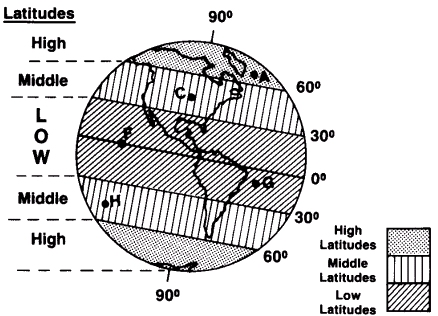
The High, Low and Middle Latitudes
There are several things that determine the climate of places on Earth. One is the distance a place is from the equator. In general, the closer a place is to the equator, the warmer it will be all year around. This is because the sun's rays strike the earth more directly near the equator, and less directly as the North and South Poles are approached.
The diagram below shows one way the Earth's surface can be divided into regions according to latitude. It is helpful to refer to a place as being in the low, middle, or high latitudes.

Of course, there are other things that affect climate. Altitude, or the number of feet a place is above sea level, is a very important part of climate. Usually, for every 1,000 feet of altitude that one goes up, there is a 3° Fahrenheit drop in temperature.
- 1. On the diagram find the latitude region of each of the places listed in the table below. Then put a check (Ö) in the box in the table that tells in what latitude region the place is located.
| Place | High Latitudes | Middle Latitudes | Low Latitudes |
|---|
| A | | | | | | |
| C | | | | | | |
| F | | | | | | |
| G | | | | | | |
| H | | | | | | |
- Using latitude only, which place shown in the diagram is most likely to have the coldest climate all year round?
A _____ or F _____
C _____ or G _____
F _____ or C _____
H _____ or A _____
A _____ or G _____
Altitude and Latitude
- Imagine that the cross-section of a mountain range shown below is located on 50°N. Place A is at sea level (0' altitude), and on a certain day it had a temperature of 40°F. Using this information, what might be the temperatures of the other places?
A: _______40°F_______
B: __________________
C: __________________
D: __________________

Challenge
The airplane shown in the diagram is flying at 20,000' above sea level. What is the probable temperature at that height? _____



